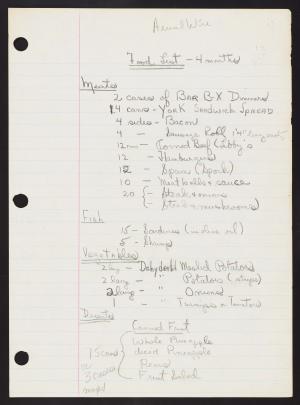Today is the first day of winter. Not ready for the cold weather? It could always be worse. Ornithologist (and future tropical biologist) Neal Griffith Smith once wrote in his journal:
"Still pensil [sic]. Well, I've got time and temperature to write. Just sharpened the pensil with a snow knife. We are parked smack in the middle of Southampton [Island] in a bloody windstorm. It is now 7:45 PM. First things first - the ink is still frozen solid, in fact everything that I own is frozen solid - camera etc. God it's cold - last night it went down to -24 [degrees] F - plus wind and that's authentic. It must be 15 [degrees] colder in the interior of this lovely tropical isle."

Clearly, Smith was not actually on a tropical isle, though he would spend most of his career working for the Smithsonian Tropical Research Institute in Panama. He was on Southampton Island in the Northwestern Territories of Canada (now known as Nunavut) and the date of this journal entry was not at the height of the winter weather, but May 9, 1960.
As a graduate student at Cornell University, Smith spent three summers in the field studying arctic birds on White, Southampton, and Baffin Islands, all in the Northwest Territories. He meticulously kept both a field book and a journal for each trip. The field books primarily include scientific data, observations, and sketches related to bird colonies and other wildlife as well the weather and terrain. The journals were narrative logs of daily life including reflections, impressions, aches, pains, and, of course, food. Many of Smith's journal entries are wonderfully descriptive and his wife, Ninochtka Smith, once wrote to me that they read like "an adventure travel story in the days when they still used dog sleds as transportation."
![Moths with Neal Smith, Panama, STRI, 1986, Smithsonian Institution Archives, SIA Acc. 11-009 [88-7156]. Moths with Neal Smith, Panama, STRI](http://ids-si-edu-s.njmu.s5.bt8.net/ids/iiif/SIA-88-7156-000002/full/300,/0/default.jpg)
On May 21, 1959, Smith describes a particularly adventurous day on Baffin Island after spending more than 20 hours on the trail:
"I've read stories about such trips but to think that I would be in such a position to experience the hardships of some of the great explorer was beyond my wildest imagination… We pitched camp in a long valley, filled with mauwa[?] (deep, deep, soft and slushy snow) at around 1:15 PM. If one knows how to read maps in special reference to conditions in the arctic, one immediately sees the fly in the ointment. I still remember Jim's fingers gliding across this land area in a fraction of a second. We haven't gotten halfway across yet and we've been at it in the land area since 6:30 PM of last night. The trouble - several both separately and collectively: soft snow and dam [sic] deep - to my armpits many many times - then no snow - just mosses and lichens or Rocks. The kamotiks [sleds] bogged down on the average of 10 times an hour and it took at least 5-10 minutes of straining, pushing, digging, whiping [sic] the dogs to set it free. If you ride on the kamotik the entire sled sinks; if you walk beside, you sink & then everything stops anyway. We pushed those kamotiks up steep hills, inch by inch - fog closed in and a light rain fell. We were chilled to the bone and could hardly keep our eyes open. The dogs haven't eaten in two days & their feet are bleeding. My cold is centered in my nose & it runs all the time. Those seal skin boots proved their worth in the newly formed streams running through & under the snow."

Many days were less adventurous, but Smith seemed to pressure himself to write even when he admitted to having little to write about. On days when the weather was particularly bad, he sometimes wrote a blow-by-blow account of each time he left the tent - to cook breakfast, to get the radio, to relieve his bladder, etc. Other times, he described the people he met, the expenses he paid, the merits of various writing implements, and the future of his journals.
"I've switched pens - and ink too," Smith noted on June 23, 1961. I'm using Higgins Engrosing [sic] in the good old red Esterbrook. The devil with the Rapid-o-graph - its furious[?] lines are too scratchy & besides, this ink is smear proof - thus my words are forever assured of their preservement! Oh what conceit!"

Little did Smith know that his words actually would be preserved forever.
Related Resources
- Neal Smith, 1937-2012, Smithsonian Tropical Research Institute,
- Neal Smith (1937-2012), Smithsonian Tropical Research Institute News
- Neal Griffith Smith Papers, 1925-1995, Accession 17-057, Smithsonian Institution Archives
- Neal Griffith Smith Interview, 1990, Record Unit 9584, Smithsonian Institution Archives
Produced by the Smithsonian Institution Archives. For copyright questions, please see the Terms of Use.

Leave a Comment